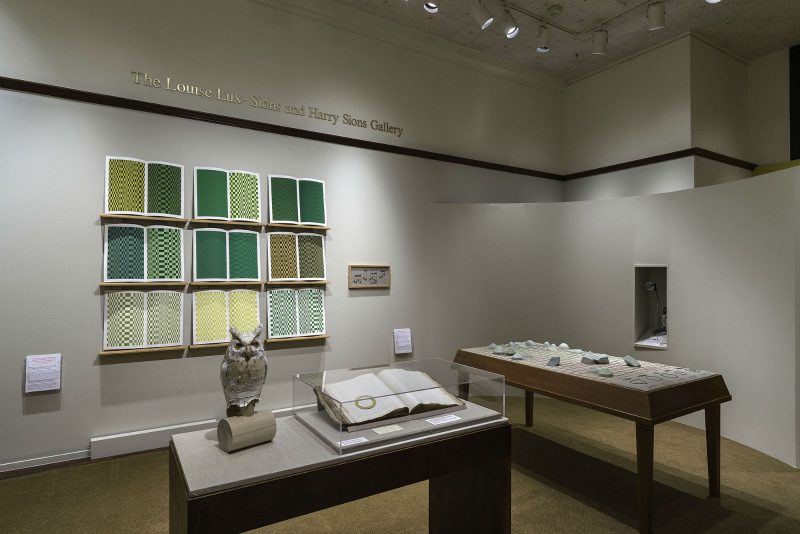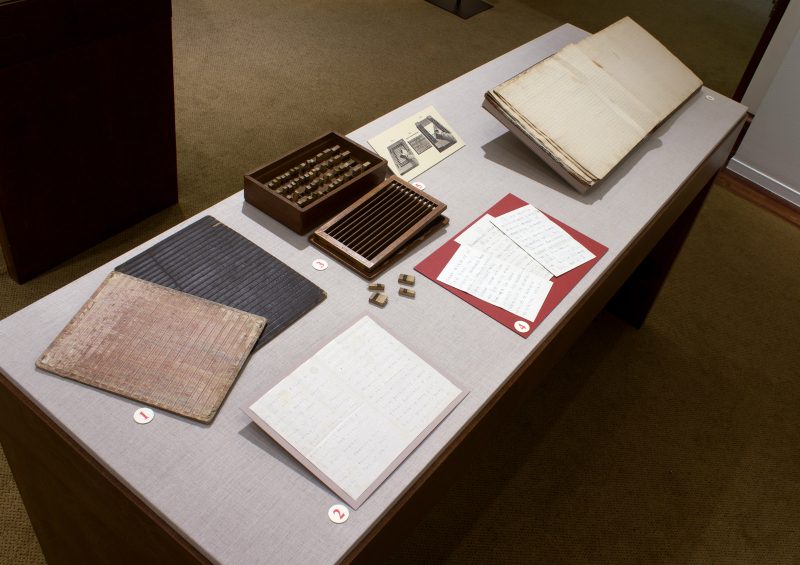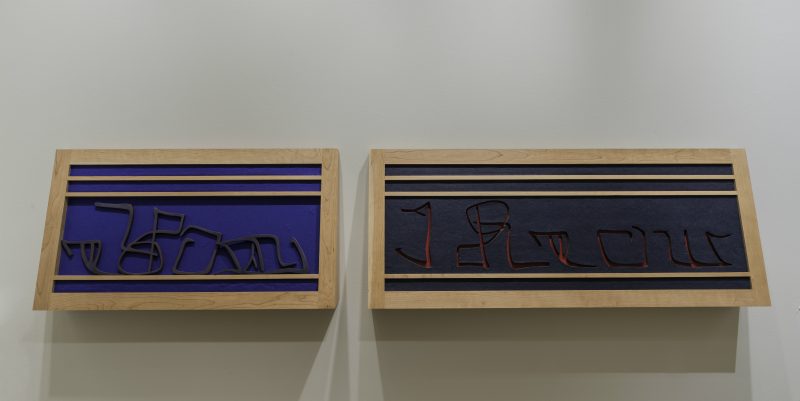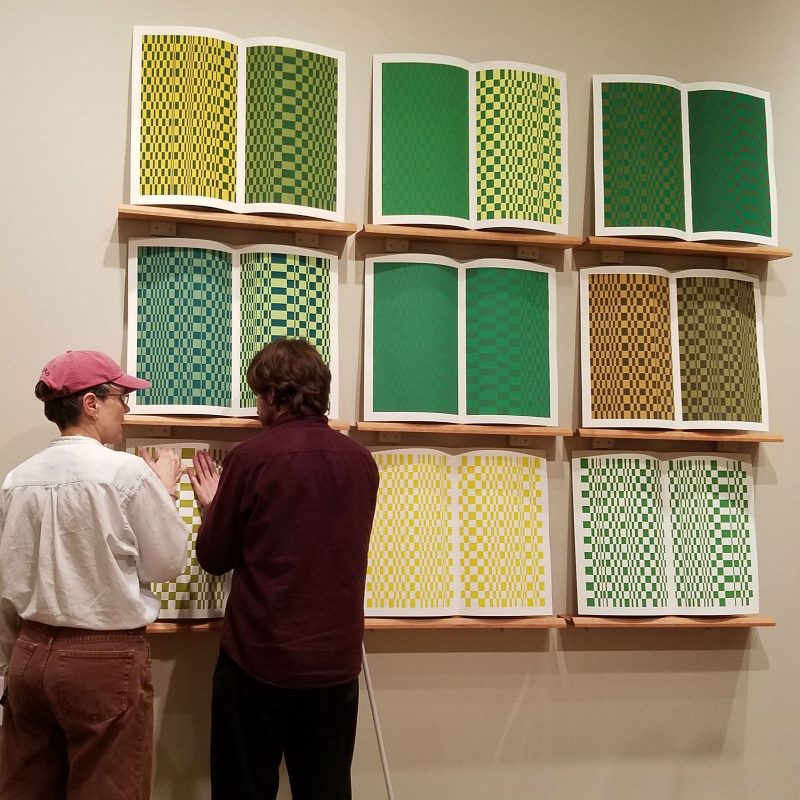In the current exhibition Common Touch: The Art of the Senses in the History of the Blind, artist-in-residence Teresa Jaynes playfully combines archival material displayed in traditional glass vitrines with objects designed to be handled by visitors. Surrounded by whitewashed walls like an open book, the artist’s multisensory objects translate 19th-century alphabets for the blind into a language of touch, hearing, and smell.
Jaynes’ thoughtful and interactive installation is based on her research in the Michael Zinman Collection at the Library Company, as well as the archives of the New York Institute for Special Education and the Perkins School for the Blind. Focusing on the transition period from alphabets in embossed writing fonts (e.g., Moon Alphabet and Boston Line Type) to punched code typefaces (e.g., New York Type and Braille), between the lines she illuminates the early history of blind education and written communication, exemplified by the stories of four courageous creators–the mathematician Nicholas Saunderson, the surveyor John Metcalf, the artisan Jennie Partridge, and the composer Thomas “Blind Tom” Wiggins.


The gift of touch
The exhibition opens with a book written in raised embossed alphabet in which the word “ME” has been secretly punched into the paper, and ends with the photograph of the blind Reverend Jacobson, staged intimately with a book next to his wife. In addition to the wooden letters, color patterned prints, geometric objects, embossed owl, embroidered map, and olfactometer, the picture is among the “gifts,” as the artist calls them, created for the exhibition. Referring to the pedagogy of Friedrich Fröbel, the 19th-century educator and inventor of kindergarten, they reflect the integration of abstract geometrical forms into the education and written language of the blind. “The gifts were directed play,” explains the artist, “to teach pattern and symmetry [and ultimately] the unity of things.”

One of the initial objects that the artist came across for the exhibition was a pair of letters written by Jennie Partridge in the 1870s, in which the educated blind woman and musician asks her benefactor for a piano and reports its successful delivery. Written in so-called “square-hand,” which imitates Roman letters, the letters are sincerely moving. “What she had to go through to learn how to conceptualize her handwriting, so that she could become confident that she was in fact writing what she had in her head” is astonishing, says Jaynes, expressing her admiration for Jennie Partridge and at the same time illuminating the artist’s “Gift #2,” consisting of large felt letterforms on the opposite wall. Try closing your eyes and matching the enlarged letters to their felt cut-out counterparts by touch and you will instantly understand the intellectual achievement and chutzpah of the writer. Partridge’s painstaking letters bridge early blind writing with later forms of communication that don’t rely purely on vision; at the same time, they highlight the creativity, volition, and growing confidence of the blind during the 19th century.

Polyphony of sound and touch
Elsewhere in the exhibition the silent language of letters and books extends into a multisensory installation. Nine doubled silkscreen prints are spread like a musical score over the wall, colored green as if to evoke the tactile softness of leaves on a tree. The prints translate Thomas Wiggins‘ piano composition “March Timpani” note-by-note into a geometrical pattern and systematic grid. Assigning a number to each note related to its position on the piano keyboard and dividing the number according to the length of the note, Jaynes creates a notation system that visually and haptically mirrors the simultaneously audible sound of Wiggins’ music, interpreted and recorded by the pianist John Davis in 2000. When one reads over the paper with one’s fingers, the structure, rhythm, and intensity of Wiggins’ music become incredibly palpable. This is synesthesia at its best–the chromatic impression of sight develops into the polyphony of sound and touch.
In the end, the exhibition Common Touch: The Art of the Senses in the History of the Blind offers more than a glimpse into the history of the blind from the depths of today’s archives. In contrast to persistent misconceptions about blindness–as if Pieter Bruegel’s sinister and mocking “The Blind Leading the Blind” (1568) still shapes our thinking today–Teresa Jaynes shifts our biased perception from a predominantly visual culture into a synesthetic experience. Speaking through the language of the fingers, she creates a tangible world that addresses issues of humanity and society that are anything but marginal. Liberate your vision and explore the nature of perception through the senses of touch, sound, and scent.
Common Touch is open until October 21th from Mo-Fr 9am to 4:45pm at the Library Company of Philadelphia. Special tours for the blind are offered by the local organization Philly Touch Tours.
Quotations from Teresa Jaynes are based on an interview with the author on May 18, 2016. For further information about the Michael Zinman Collection visit the Library Company’s research site.









